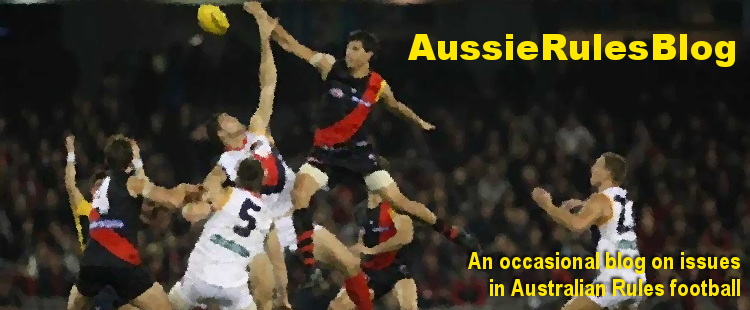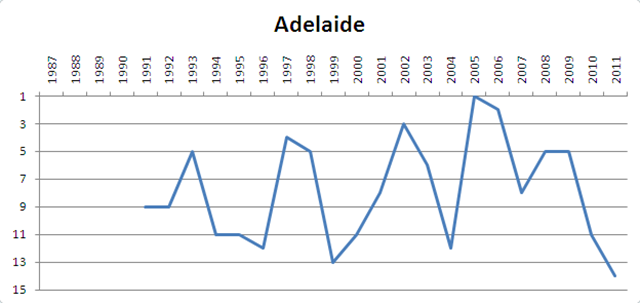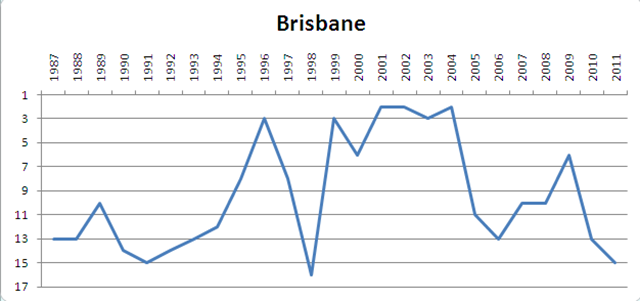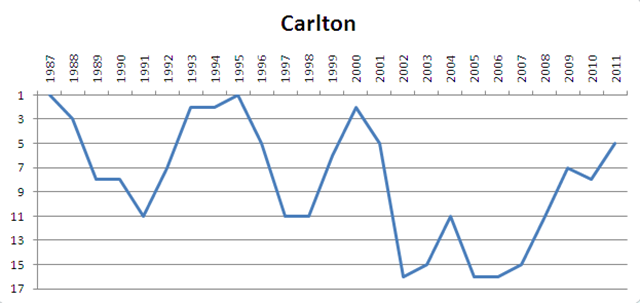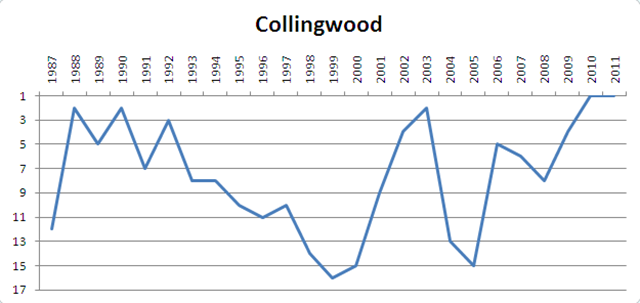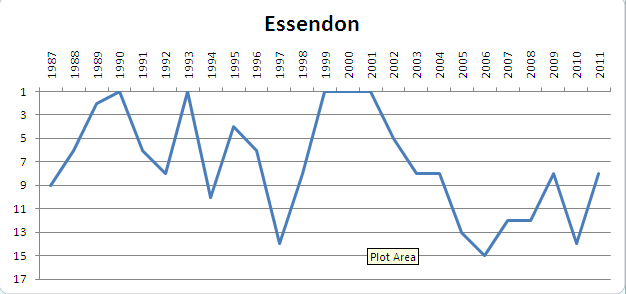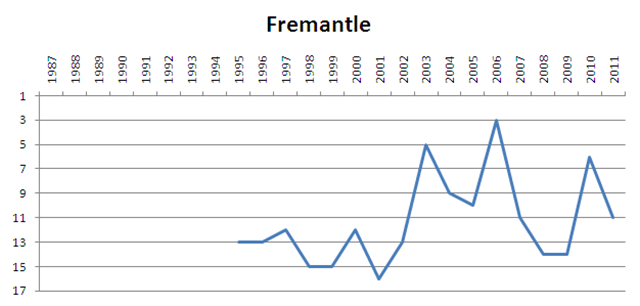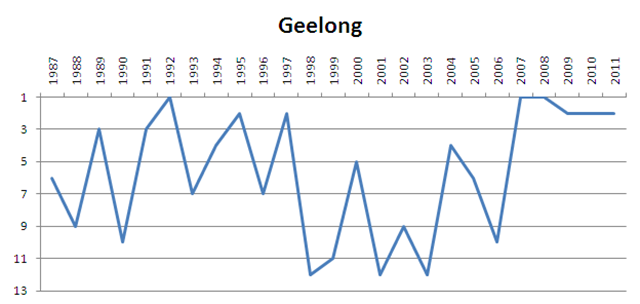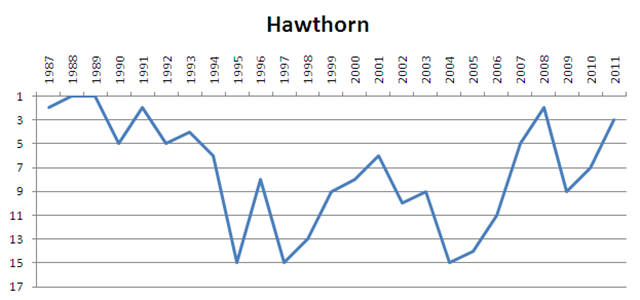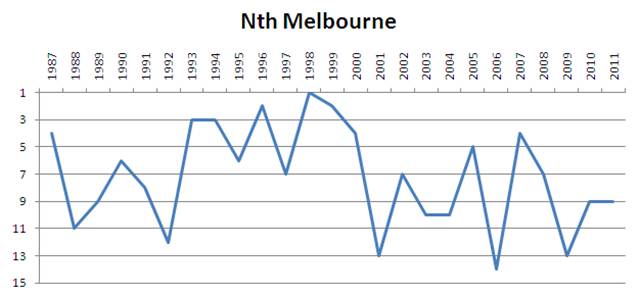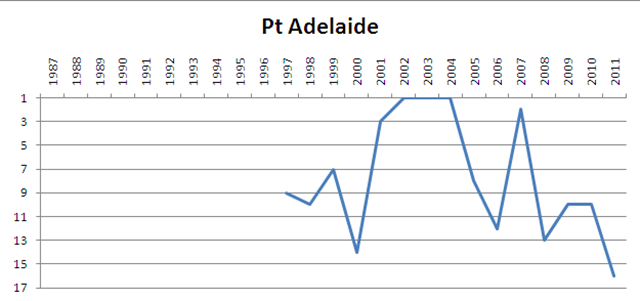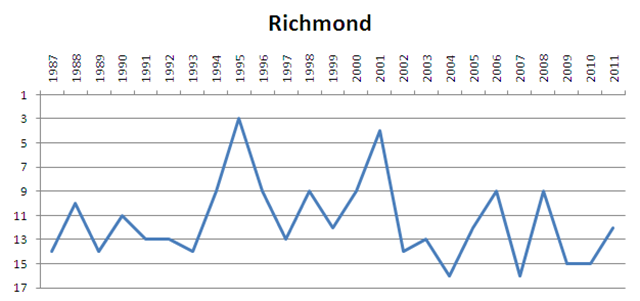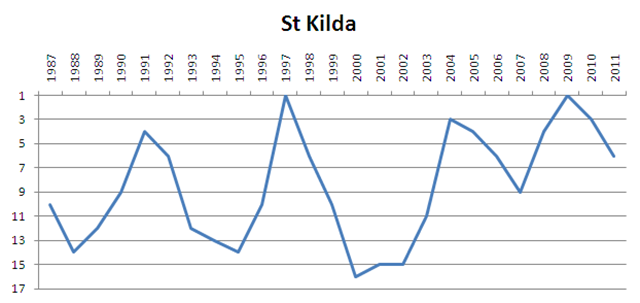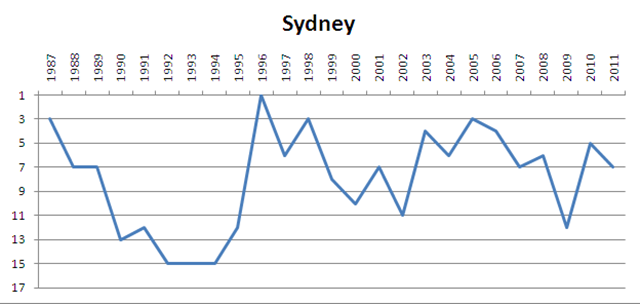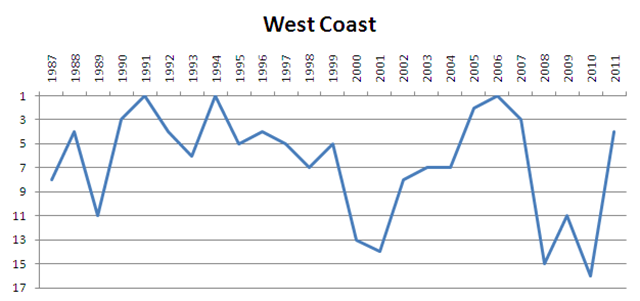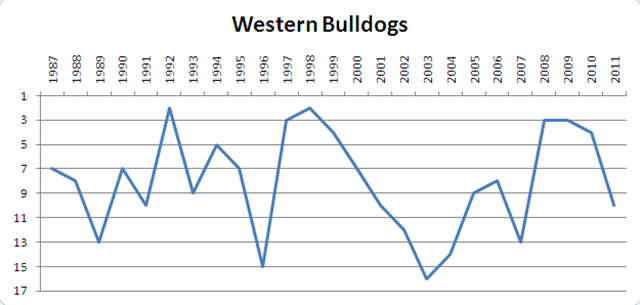From feeling quite nervous about the Barcodes winning at three-quarter time, AussieRulesBlog’s demeanour improved markedly as the final quarter unfolded. The Cats had, in our view, looked far more dangerous all day, while the Barcodes had made the most of their opportunities to keep themselves very much in the game right through to mid way through the final quarter.
When the game broke, it broke in a big way and the result didn’t truly reflect the intensity of the competition for the ball.
It was certainly far more pleasant walking away from the G after a Pussy Power triumph than it would have been with a Barcodes victory. We’ve suffered plenty of defeats at the hands of the Barcodes and their fans can be in your face and obnoxious in their gloating. It was a very civil end to the day yesterday.
The day was made far more interesting for AussieRulesBlog in anticipating, and then marvelling at, the pre-game.
Arriving at our seats, we couldn’t fail to notice a rather large facsimile Premiership Cup standing on the centre circle, standing perhaps eight metres tall.
As the time for football approached, ten or so black-clad ‘roadies’ appeared through a gate in the boundary fence. Each was carrying a white box. Ikea was our first thought, quickly followed by Lego.
The roadies installed these boxes in a line just inside the centre square and then retreated to the boundary again. Soon they reappeared and placed another five boxes, then proceeded to bring out yet more boxes and line these up on the other side of the centre square. A quick count suggested something to do with Premierships won.
What a good thing they hadn’t used this idea last year! Imagine the Barcodes fourteen boxes on one side and the Saints lonely single box on the other! But we digress.
Retiring players (and umpires) were paraded around the ground, followed by Rising Star, Dyson Heppell.
Craig Willis’ stentorian tones began announcing former Barcodes players and they began appearing from within the teeming mass that is the Barcodes cheer squad, carrying a Premiership Cup each. They walked in a rag-tag fashion, toward the line of boxes — now revealed to be plinths — and placed the cups atop the plinths.
Next the same happened with the Geelong Premierships from the Cats’ cheer squad end, except that the former Cats made the Barcodes greats look like a precision drill team, such was the disorganised nature of their progress toward their plinths. Organisation? Planning? Rehearsal? Telling participants what they’re expected to do and when? These are foreign concepts to those charged with AFL Grand Final ‘Spectaculars’.
In the end, one of the Geelong Cups appeared from the direction of the interchange benches and former Geelong captain, Stephen King — carrying the obligatory child: We’re coming around to Brian Taylor’s thinking on this — had to sprint from the parade of retirees to the parade of former champions carrying Premiership Cups. Organisation? Did no-one think to wonder how King would participate in these two ‘entertainments’?
Next, a roar of Harley Davidsons — have we just coined a new collective noun? — was heard and then seen on the big screen riding up a ramp and out onto the boundary verge. Not surprisingly, this signalled the beginning of Mr Loaf’s contribution to proceedings. Also not surprisingly, the Harleys fitted nicely with Mr Loaf’s rendition of Hot Patootie, famously sung in The Rocky Horror Picture Show by Mr Loaf astride a Harley!
We here at AussieRulesBlog Central are partial to a bit of Mr Loaf. He’s not on high rotation, but a bit of Bat Out of Hell or Paradise by the Dashboard Light can gladden our hearts occasionally, so we were quite looking forward to this performance.
It’s worth mentioning here that we attended five MCG finals this year, being lucky enough to have access to a series ticket and buying a ticket to see the Bombers in week one. For the previous finals, musical acts had provided pre-game and half-time entertainment. From where we were sitting, beneath the scoreboard in the Ponsford Stand, the bands were extremely loud but the sound quality was otherwise quite acceptable.
Having mentioned that, no-one will be surprised to learn that the sound for Mr Loaf, at least where AussieRulesBlog was sitting, would still have been abysmal if it had been improved by 400%. For some reason known only to the organisers, they had foresworn the perfectly good, albeit extraordinarily loud, MCG sound system and instead wheeled out speakers on little trolleys that were last used in the days before the redevelopment of the northern side of the stadium. What emerged from these toy speakers was undoubtedly a cacophony, but little of it was recognisable as Mr Loaf’s work.
Whilst Mr Loaf had been purveying his wares, one of the event staff came out onto the field and gave directions, individually, to the former Barcodes players still standing dutifully by their Premiership Cups. We were somewhat stunned to realise that said event person was repeating the same instructions to each former player — and some of them weren’t keen to buy! Organisation? Planning? Rehearsal?
Eventually, by the end of Mr Loaf’s set, the former players had retired to parts unknown and the Premiership Cups stood resplendent on their plinths, alone and unassisted (bar a sandbag each to keep them in place).
We had been curious that two drum kits on wheeled trolleys had been rolled out during the aforementioned Meat Loaf performance. They weren’t involved in the performance, but just sat there. Also during Meat Loaf’s gig, two groups of scarf-wearing people were escorted onto the arena, one to each end. Once Meat Loaf had finished, the wheeled drum kits were pushed to the top of the goal square at each end and sundry musicians appeared and plugged in their guitars. The two groups of people turned out to be two “choirs” whose task it was to belt out the respective club songs. They seemed not to be plugged into either the MCG sound system, nor Meat Loaf’s, because the Geelong choir’s rendition of the Toreador Song, at the other end of the ground, was very muted.
As the choirs sang, two helium balloons in the (rough) shape of a Sherrin football were elevated to about twenty metres and a banner for each club was unfurled as their song was performed. It was breathtakingly innovative and spectacular — NOT!
Now the former players of both clubs returned to their respective Cups, and retrieved them to two lines forming a ‘Guard of Honour’ before yet another plinth on which the actual Premiership Cup for 2011 would sit. We can’t say it was a total surprise, but we were nevertheless gobsmacked to see a door open in the base of the large Premiership Cup facsimile and a gent emerge carrying the real thing. The Cup was presented to Doug Wade and Murray Wiederman who would present the Cup in the event that either Geelong or Collingwood, respectively, won the game.
And then there were the Ross Oakley memorial fireworks, after which is was all but impossible to see the crowd on the other side of the ground.
Was the fun over? No on your life. The Premiership Cup facsimile which had stood at centre field was transported to the boundary where a team of construction workers disassembled it using tools including a scissor lift and a forklift — a process that seemed to occupy ten minutes of none-too-frantic activity.
Soon after, to everyone’s relief, a game of footy broke out and two hours was spent savouring a wonderful game.
At the conclusion of the game, the MCC, in it’s infinite wisdom, rolled out one of its officious besuited types leading half a dozen MCC staff along with two contraptions for dispensing rope. These people proceeded, Keystone Cops-like, to construct a rope barrier in front of the dais where the Premiership Medal and Cup were to be presented. Clearly the requirements of the task had not been discussed previously (or the staff were all cloth-eared twits, which is not completely impossible!), because the ensuing action was worthy of a slapstick comedy award. Quite why these worthies were erecting a barrier when unauthorised entry to the playing arena carries a $7,000 fine quite escapes us. And the ‘barrier’ would stop who or what? It’s a rope for goodness sakes.
And so ended our big day. The game had lived up to the billing. The result was the one we preferred. The atmosphere was civil at the end of the game. The pre-game entertainment was an amateurish shambles. Our Grand Final experience was complete.
